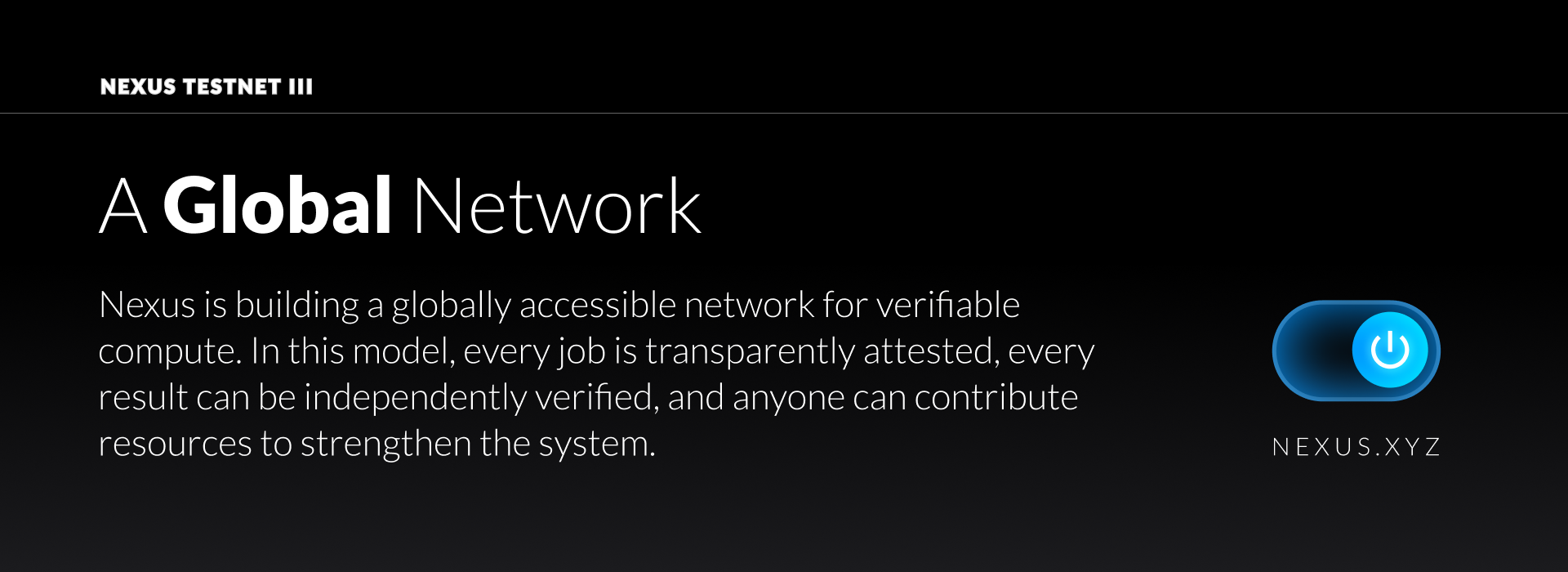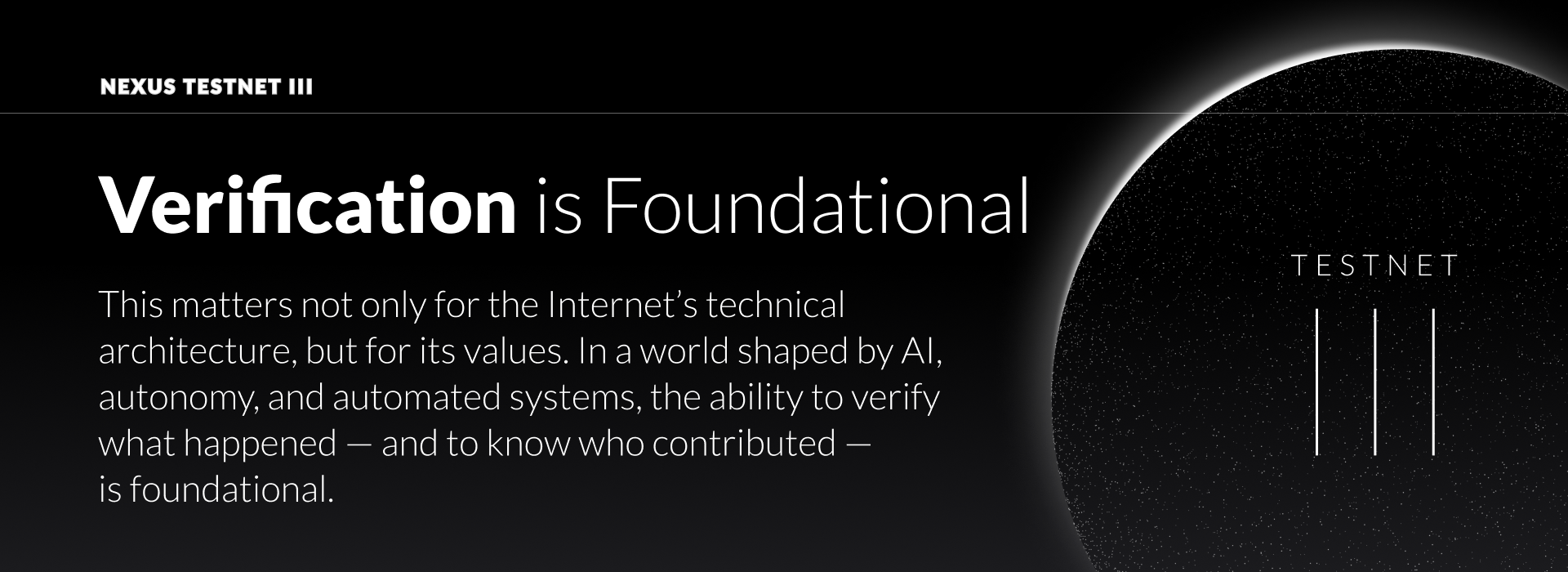Nexus Community Report: AMAs, dApps, and Creator-Driven Culture
As we welcome December, the Nexus ecosystem continues accelerating across protocol development, global community engagement, and creator-driven culture. This week

Testnet III moves us one step closer to making the Layer 1 for the AI era universally accessible. No specialized hardware. No deep technical background. Just a browser and the willingness to contribute.
From the Nexus OS, you can now set up a wallet in seconds, begin contributing compute power, and earn rewards for doing so.
By participating, you are not only helping test infrastructure — you’re actively shaping the foundation for the verifiable world. Every job run and every node connected contributes to scaling verifiable compute across the globe. Each node that joins makes the network more powerful.
Testnet III starts at 9:00 am PT on Monday, June 23.
We’re rolling out Testnet III in staggered phases to ensure the most stable and performant experience for everyone. Throughout the day on June 23, we’ll go live in the United States, Vietnam, Nigeria, Russia, India, Indonesia, the United Kingdom, and Hong Kong SAR and Mainland China — then across the rest of the world on June 24. These first eight countries saw the most participation during Devnet.
Testnet III runs until the Nexus Mainnet launch later in Q3. Unlike past Nexus testnets, participants in every country now have weeks — not days — to contribute to the Nexus supercomputer and earn rewards.
Millions are ready to join Testnet III. We’re taking this phased approach to deliver the best experience possible to every participant from the very beginning.
We’re deeply grateful to our community. Thank you for making Testnet III a success.
Get started at app.nexus.xyz
With Testnet III, the Nexus OS becomes more than a protocol interface — it becomes a live, legible gateway. Every new feature is designed to reduce friction, amplify visibility, and make contribution feel personal and rewarding. If you’re curious about what’s on the inside, here’s what’s waiting for you:
When you open the Nexus OS, the first thing you’ll notice is the map. It’s not just a visualization — it’s a snapshot of where compute is flowing and who’s making it happen. From Seoul to São Paulo, contributors are running jobs, verifying results, and helping power a new kind of Internet.
If you are new to Nexus, the map is a simple and powerful way to understand how the network works. For veterans, it’s a radical departure from our previous infrastructure. Either way, it makes one thing clear: Nexus is a growing network that is getting built node by node.
In most distributed systems, you contribute quietly and disappear. In Nexus, your work earns recognition.
The leaderboard is a new public surface for highlighting the most active and consistent contributors across the network. It brings visibility and a bit of friendly competition to the protocol, showing who’s pushing things forward. Whether you’re contributing on a personal laptop or running dozens of jobs via the CLI, your place on the board reflects your impact in the network’s growth.
The leaderboard shows momentum. By making contributions legible and shareable, we’re turning abstract compute into real community progress. As rewards evolve and protocol governance takes shape, this early participation becomes even more meaningful. Being early matters — and now, it’s visible.
With Testnet III, users can now link their social accounts — Twitter and Discord — to their Nexus experience. This simple feature unlocks a new layer of credibility and persistence for contributors. Instead of being just a wallet address or ephemeral session, your presence in the network becomes recognizable, reputational, and repeatable.
For builders, this means your work travels with you. For explorers, it offers a way to stake identity alongside contribution. For the protocol, it creates the foundations of a system rooted in verifiable action.
It also lays groundwork for discovery and collaboration. As more contributors come online, social linkage makes it easier to find like-minded peers, follow power users, and surface meaningful participation. This is a network built not just on compute — but on people.

For power users, speed and flexibility matter. The new one-line CLI login removes barriers and makes getting started as simple as copying a single command. No multi-step setup. No SDKs. No API keys. Just authenticate and start contributing directly from your terminal.
Whether you’re building automations, scheduling batch jobs, or integrating Nexus into broader developer workflows, this update turns the CLI into a serious tool for participation. It also brings the protocol closer to the norms of open-source infrastructure: scriptable, transparent, and under your control.
More importantly, it means there’s no ceiling to how you contribute. You can start as a one-click user in the OS, but grow into a developer running customized workloads on your own terms.

The Internet today runs on compute, but we rarely see how — or where — it happens. Most of what powers our digital world is hidden behind proprietary infrastructure and unverifiable execution. As a result, trust online is increasingly strained and dependent on brand reputation rather than cryptographic truth.
Nexus is building a different foundation: A globally accessible network for verifiable compute. In this model, every job is transparently attested, every result can be independently verified, and anyone can contribute resources to strengthen the system. It’s a shift from blind trust to mathematical assurance, from centralized control to distributed participation.
This matters not only for the Internet’s technical architecture, but for its values. In a world shaped by AI, autonomy, and automated systems, the ability to verify what happened — and to know who contributed — is foundational. It’s how we build confidence in the outputs we rely on, and ensure that incentives flow to the people who make them possible.
Joining Nexus means becoming part of this shift. It means contributing to a public good, earning verifiable rewards, and helping define the infrastructure of the future.